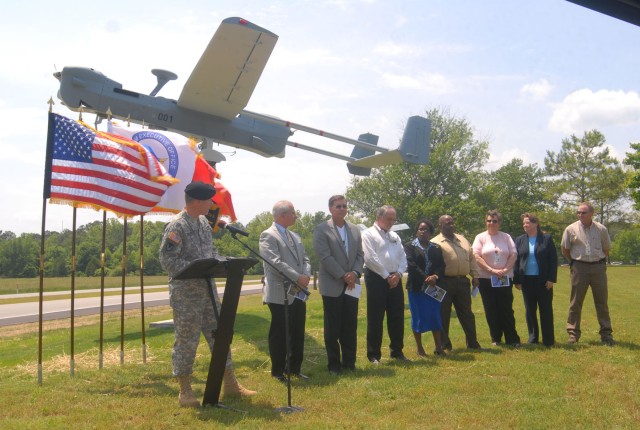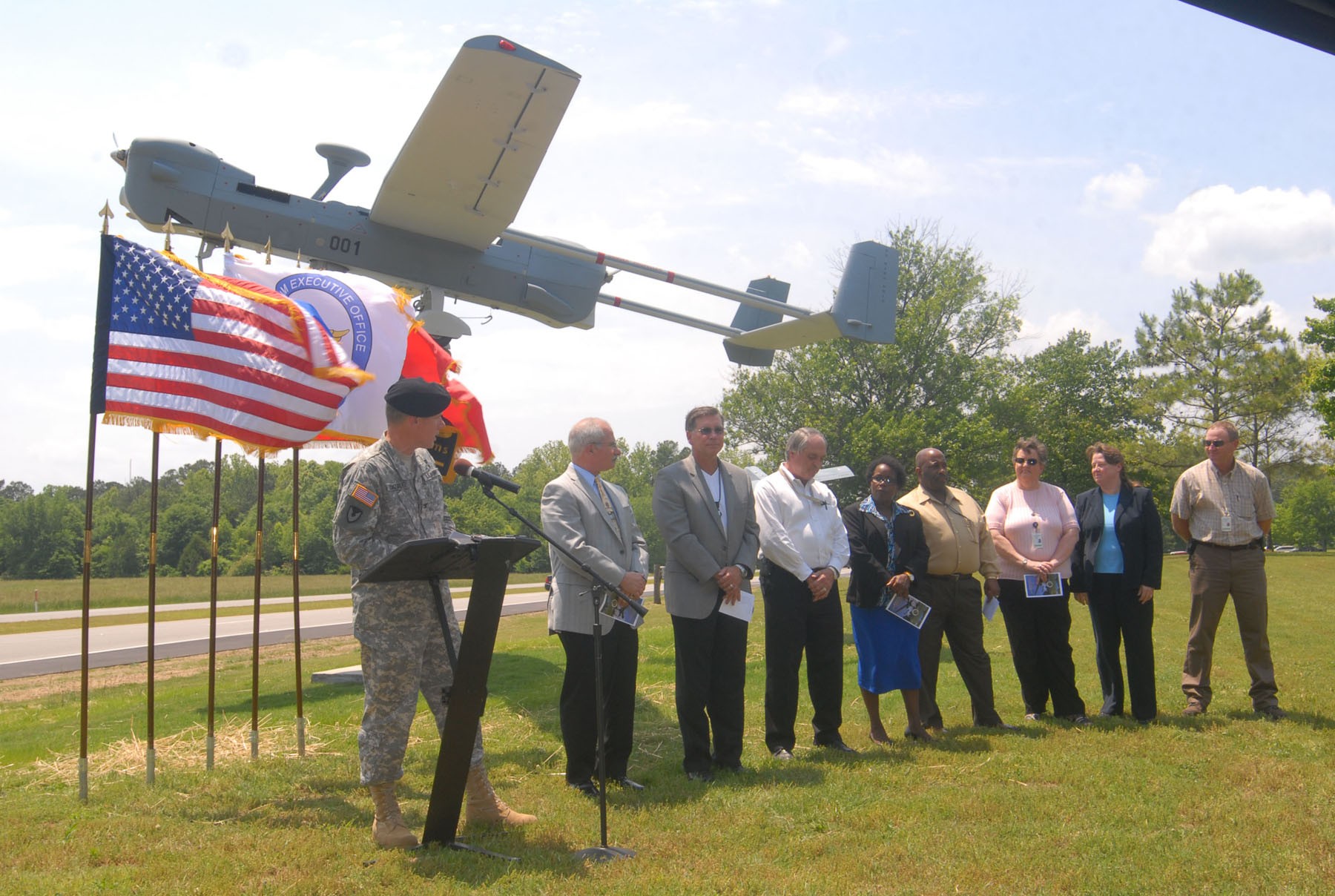REDSTONE ARSENAL, Ala., May 19, 2011 -- It was the first unmanned aircraft system to be tested. It was the first to be sent to the battlefield. It was the first to carry a weapon and the first to communicate with Soldiers on the ground.
It is the Army's longest serving short-range unmanned aircraft system used at the corps and division level.
Described as the workhorse for unmanned aerial vehicles and credited with paving the way for other unmanned aircraft to be developed and fielded, the MQ-5B Hunter Unmanned Aerial Vehicle set the standard for the Army's unmanned aircraft systems program, which now flies a fleet of unmanned aircraft in both Iraq and Afghanistan in support of the warfighter on the ground.
And it did so without a budget.
"This program has had a very interesting history. It started out rocky, but has been successful. It has had a tremendous history," said Col. Gregory Gonzalez, project manager for the Unmanned Aircraft Systems Project Office.
"It was the little program that they thought couldn't, that actually did. People had little faith in unmanned aircraft. This is a true testament of keeping behind a particular program to see what it can do," he said.
Employees of the Unmanned Aircraft Systems Project Office along with participants in last week's Aviation Synchronization Conference held at Redstone Arsenal, Ala., gathered for the dedication of a MQ-5B Hunter Unmanned Aerial Vehicle, May 12, 2011, which is now mounted on a platform just outside the Sparkman Center.
The Unmanned Aircraft Systems Modernization Product Office coordinated the mounting of the Hunter display as a fitting representation of the Hunter team's continued support to the warfighter.
"It really is an event that requires special recognition for not only the aircraft itself, but also for the hard effort and work of employees, and the Soldiers and contractors who have been flying this very successfully for years and years," Gonzalez said.
The Hunter now on display is marked as 001, one of the first used for developmental testing and training.
"It represents the very earliest system that was fielded," Gonzalez said.
In 1988, a joint project office for unmanned aircraft vehicles was established with the Navy as the lead service. The mission was to develop short-range and close-range unmanned aircraft vehicles. Hunter was the first system developed, with 15 systems built by Israel Aircraft Industries and TRW in 1989.
In 1993, with testing complete, the Department of Defense ordered seven Hunter systems of eight aircraft each, for a total of 56 additional aircraft; and management of the program, known as the Remotely Powered Vehicle Program, was moved to Redstone.
"But then there were untimely incidences with the aircraft, and in 1996, we terminated full rate production of Hunter," Gonzalez said, omitting it from the government budget process as a program of record.
"We almost got it into a program and then it was axed," said Bill Smithson, who has worked on the Hunter program since its inception.
In late 1995, Hunter was fielded at Fort Hood, Texas, and acceptance of the system was imminent, until the system had three mishaps in three months.
"We had three crashes. We did not know what was causing the problem," Smithson said.
Investigation of the entire procurement process and the Hunter system determined that a manufacturer change in the wing control system had caused the mishaps.
"So, we fixed the problem. But then all we could do was field and train until some other UAV system came along," Smithson said.
Even with production stopped, there were still more than 65 Hunters in the DoD inventory.
"The Army wanted to take advantage of the procurement. But it didn't have a specific mission and there was no program of record so it was hard financially," Gonzalez said.
Training with the Hunter was ongoing at Fort Huachuca, Ariz., and Fort Hood where Soldiers and civilian contractors learned how to operate and maintain it. But until there was a mission, Hunter was pretty much grounded.
And then came Kosovo in 1999.
"We needed a real calling for these aircraft," Gonzalez said. "It was deployed to the Balkans for a NATO peacemaking and then peacekeeping mission."
Kosovo became the event that set the Army's unmanned aircraft systems program on its present day course.
"Hunter was the only UAV in the Army inventory," Smithson said. "It had a mission after all. It was a line-of-sight aircraft that had relay capability so it could fly dual missions in the mountainous terrain. It flew 4,000 hours a year, which was really only seven months because weather made it impossible to fly from October to February.
"We flew like that for four years in a row. The Hunter did a lot of great work and the Army began to recognize the valuable asset of UAVs for saving lives and situational awareness."
Then, in 2003, Hunter became the first unmanned aircraft to deploy to a war zone, going to Baghdad, Iraq, with the 3rd Infantry Division.
"Hunter was the only UAV initially there," Smithson said. "Hunter was the only thing we had to support the Soldiers and the commanders in the field. It was the only UAV asset in the war at that time. It was the only game in town."
Also, in 2004, the Department of Homeland Security, Customs and Border Protection Bureau, and Office of Air and Marine utilized Hunter under a trial program for border patrol duties. During this program, the Hunter flew 329 flight hours, resulting in 556 detections.
But Hunter's real contributions were on the battlefields of Iraq and Afghanistan, where its reconnaissance, surveillance, targeting and acquisition capabilities quickly won over Soldiers and commanders.
Three Hunter units - Alpha 1st, Alpha 15th and Alpha 224th - rotated deployments into Iraq, and then Afghanistan. Besides Soldiers, contractors were also deployed to operate and maintain Hunter. Its operational availability has hovered at more than 98 percent since it went into operation.
The Hunter takes off and lands on runways, can fly more than 40 payloads and can carry up to 300 pounds of payload. Its imagery system allows data to be processed in a matter of seconds, providing virtual, real-time information of battlefield conditions and targets.
The Hunter's enhanced imaging system allows commanders to detect, identify and track hostile activity and targets for external weapons systems or maneuvers and battle damage assessment, thereby enhancing the commander's ability to locate and identify friendly forces to avoid unnecessary loss of life and locate enemy targets.
Northrop Grumman and TRW, which now provide equipment and support for the maintenance and sustainment of Hunter as well as its modernization, also equipped the Hunter with the GBU-44/B Viper Strike weapon system.
"History continues today. Hunter has flown 100,000 hours, with 70 percent of those flown in combat," Gonzalez said. "It was the right answer at the right time. Its flexible capability made the difference."
Plans to mount a Hunter aircraft for display at Redstone began in early July 2010, with Maj. Calvin Lane, then the Hunter assistant product manager. Aircraft tail number 001 was delivered to Redstone in late September and was located at the Joint Software Integration Laboratory for the Redstone facilities personnel to take final measurements off the aircraft to begin the fabrication of the mount.
The structural design was finished in early October, and was completed and delivered by mid-January. The Hunter display mounting activities officially began April 5, and were completed the next day.
Gonzalez recognized several employees during the Hunter dedication, including retired Col. Michael Hamilton, who led the Hunter program during the Kosovo deployment; retired Col. Donald Hazelwood, who led the Hunter program from 2005-08; and Odeal Richardson, Dennis Radford, Ferne Wlodarski, Donna Hightower and Smithson, who have all worked on the Hunter program from its early years.
Hightower, the Hunter's deputy program manager, was among many who appreciated the dedication event.
"It's awesome. But really the key to all this are the Soldiers and all the lives Hunter has saved," Hightower said. "The Hunter has helped bring home Soldiers to their families."
Even for all its success, Hunter is still not a budgeted Army program. And with other unmanned aircraft systems such as Shadow, Raven and Gray Eagle now in the Army fleet, it is unlikely new Hunter systems will be built to replace a now older fleet of 45 remaining aircraft.
"We operate on a shoe-string budget," Smithson said. "But I still enjoy it. I love working with the Hunter and it's a pleasure to get to talk to the Soldiers who operate it and maintain it in the field. We will continue to struggle to get funding while also working to help the warfighter out."
Related Links:
Army.mil: Science and Technology News
STAND-TO!: U.S. Army Roadmap for Unmanned Aircraft Systems: 2010-2035


Social Sharing